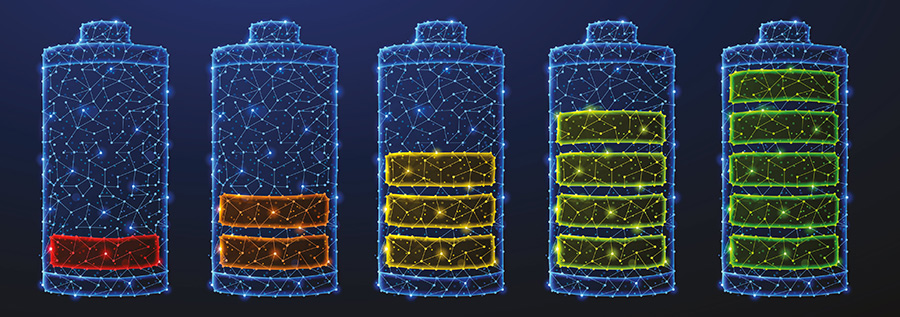The life of a lithium-ion battery
If you’re reading this on a laptop or mobile phone, it’s likely powered by a lithium-ion battery – a huge amount of our everyday technology, from computers to medical devices and electric vehicles, relies on them. With so much demand, it’s no surprise that there is a significant amount of research into maximising the efficiency of lithium-ion batteries and working towards sustainability throughout their life cycle.
Batteries of any type are essentially energy storage units, storing electrical energy as chemical energy until its needed to be converted back into electricity. Batteries are built on chemicals – in the simplest terms there are always two electrodes, usually made of metal, and a chemical in between that allows a flow of electrical charge from one electrode to the other. This flow of electrical charge is made of ions (an atom that has gained or lost an electron), and in a lithium-ion battery the chemical carrying this flow contains lithium, hence the name.

A single-use battery can only discharge its energy once, but lithium-ion batteries are rechargeable, which makes them ideal for our portable technologies and a less wasteful, potentially more sustainable alternative to single-use batteries. But how sustainable are they?
Building a battery
Lithium is mined, which unfortunately is not good for the planet or the communities around the world that live close to lithium deposits. These issues are part of the debate around the environmental impact of electric vehicles; on the one hand, they don’t emit carbon dioxide or other pollutants when driven and the energy to run them can come from renewable sources, but can this offset the environmental impact and carbon emissions of their production? In addition, the energy needed for lithium-ion battery manufacture could come from fossil fuels, further impacting its overall sustainability.
A straight line or a circular life cycle?
While lithium-ion batteries can be recharged many times, they usually only last between five and ten years before their performance begins to degrade and can no longer hold a full charge. You may have noticed this most obviously in a mobile phone – when you first begin using the device a full charge may easily last 24 hours or more, but after a couple of years it won’t see you through the day. This is the beginning of the end for a lithium-ion battery.

Lithium-ion batteries are currently hard to recycle due to their complexity, so they can’t have a circular life cycle. There are lots of different components that need to be disassembled carefully, making it a costly procedure, and it’s not always possible to extract individual materials such as lithium. It’s thought that only around 5% of lithium-ion batteries are currently recycled; most simply go to waste.
It’s not all doom and gloom, however. There is a huge amount of scientific research invested in batteries, whether it’s focused on making them more efficient, using different materials in their manufacture, or finding ways to separate the components at the end of their useful life ready to be recycled. And there are uses for lithium-ion batteries that are no longer able to hold a full charge. As their batteries become more efficient, the second-hand battery market is growing for electric vehicles. There are also people all over the world using old lithium-ion batteries from laptops to build home energy storage solutions, helping to create a sustainable recycling solution.
Ruth Kirk is a science writer based in the UK.
Nice! The life of a lithium-ion battery typically spans 2-3 years or 300-500 charge cycles, depending on usage and care. Factors like temperature, charge/discharge rates, and depth of discharge influence longevity, with gradual capacity loss over time.